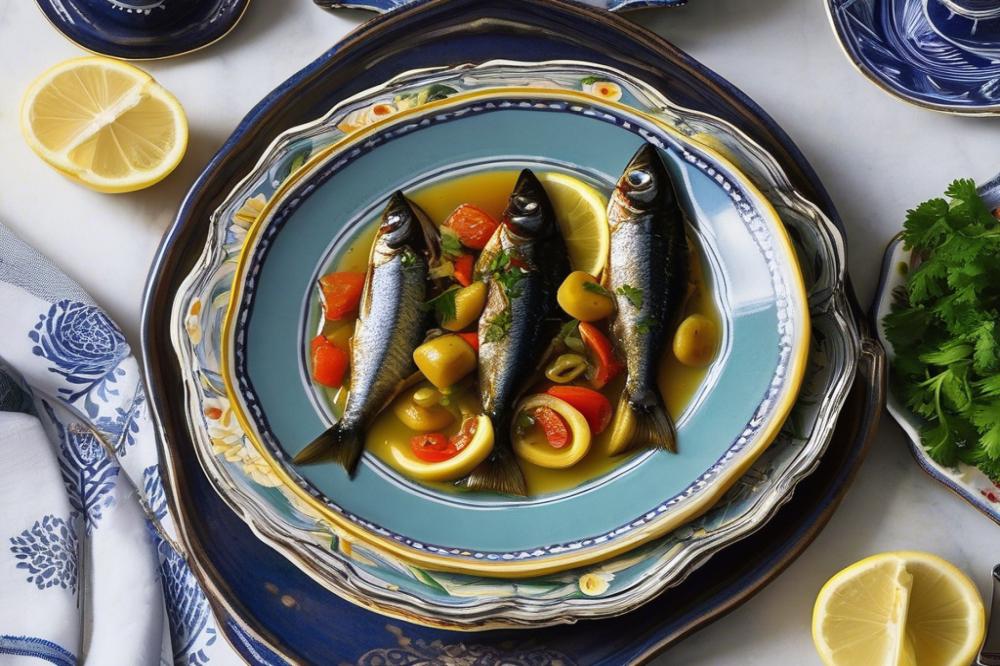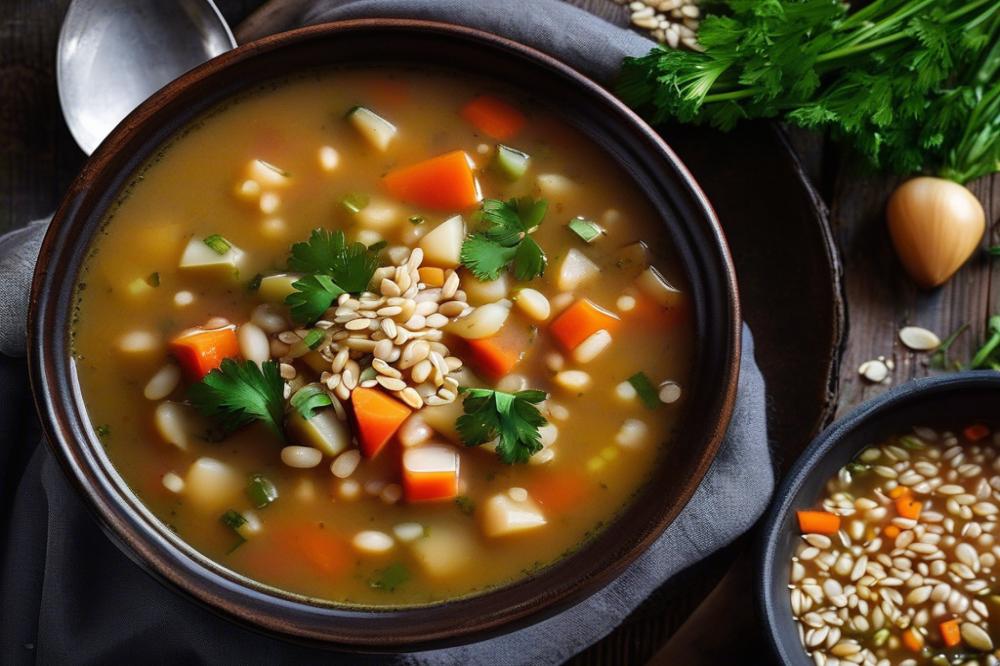Understanding sardinhas de escabeche
sardinhas de escabeche is a traditional Portuguese dish that highlights the rich flavors of marinated fish. In the Mediterranean region, fish preservation techniques are vital. They help prevent spoilage and allow people to enjoy seafood for longer periods. Many cultures have their own ways of preserving fish, but the method used in Portugal stands out for its simplicity and taste.
Marinated fish recipes, like those featuring sardines, are beloved in Portuguese cuisine. They offer a perfect balance of flavor and nutrition. Sardines are not only affordable but also packed with omega-3 fatty acids, making them a healthy choice. Additionally, preparing fish at home means you can customize the flavors to your taste. Homemade pickles can enhance the enjoyment of a meal, providing a fresh and tangy contrast.
The cultural significance of sardine preparation in Portugal cannot be overstated. For generations, families have gathered to enjoy this seafood delicacy. Festivals often celebrate the sardine, making it an important staple of Portuguese food. Throughout the country, you will find numerous seafood recipes featuring this fish.
People are drawn to the idea of making their pickled sardines. It connects them to their heritage and allows them to savor traditional flavors. When learning how to make these marinated fish, one experiences not just a recipe but a piece of Portuguese culture. From the ocean to the table, sardinhas de escabeche represent more than a meal; they embody a way of life.
What are Sardinhas de Escabeche

Sardinhas de escabeche are pickled sardines, a beloved traditional dish in Portuguese food culture. This method of preparation involves marinating sardines in a mixture of vinegar, spices, and sometimes vegetables. The result is a flavorful, preserved fish that highlights the rich maritime heritage of Portugal.
The origins of this dish can be traced back to the Mediterranean, where preserving fish was essential for survival. Seafarers and fishermen began using vinegar and spices to extend the shelf life of their catch. Over time, this culinary practice evolved, leading to the unique flavors and techniques found in various regions of Portugal.
In coastal areas, sardine preparation often reflects local ingredients and preferences. For instance, some regions might incorporate regional spices, while others may experiment with additional herbs. Variations exist, such as the use of different types of vinegar, which can alter the overall taste profile. Some families may have their own cherished recipes, passed down through generations, adding to the rich tapestry of seafood recipes in Portuguese cuisine.
Homemade pickles offer a delightful way to enjoy fish preservation. The marinated fish can be served in numerous ways, from sandwiches to salads. Portuguese recipes may include side dishes that complement the sardines, highlighting fresh vegetables or crusty bread. Such dishes showcase the diversity of flavors and textures, appealing to a broad range of tastes.
In essence, sardinhas de escabeche exemplify the Mediterranean cuisine’s emphasis on preserving the bounties of the sea. They not only serve as a delicacy but also tell a story of culture, history, and regional innovation. Each variant brings a new twist to this time-honored tradition, making it a staple in both homes and restaurants.
Ingredients and Quantities

To prepare a traditional Portuguese recipe for sardinhas de escabeche, gather the following ingredients:
- Fresh sardines (1 kg)
- Olive oil (250 ml)
- White wine vinegar (200 ml)
- Onion (1 large, thinly sliced)
- Garlic (4 cloves, minced)
- Bay leaves (2)
- Black peppercorns (1 tsp)
- Paprika (1 tsp)
- Salt (to taste)
Each component plays an essential role in the curing process. Fresh sardines are the star of this dish. They provide a rich source of protein, delivering about 20 grams per 100 grams. These small fish are also packed with omega-3 fatty acids. Including sardines in meals supports heart health and reduces inflammation.
Olive oil is another crucial ingredient in this seafood recipe. This healthy fat offers monounsaturated fats, which can positively affect cholesterol levels. One tablespoon contains approximately 120 calories, accompanied by vitamin E and antioxidants. These nutrients help protect the body from free radicals.
White wine vinegar contributes acidity and brightness to the dish. Although it has few calories, its distinct flavor enhances the marinated fish. The onions and garlic are more than just aromatics; they add depth and character. Onions provide vitamin C, while garlic is known for its immune-boosting properties.
Spices such as black peppercorns and paprika elevate the overall taste. A teaspoon of black peppercorns offers additional antioxidants. Paprika not only provides color but also vitamins A and E, benefiting skin health and vision.
During the process of fish preservation, the salt is imperative. It not only helps in flavoring but also acts as a preservative. Proper salting can extend the shelf life of homemade pickles like these sardines. When balanced correctly, all the ingredients meld together, creating a unique marinade that encapsulates the essence of Mediterranean cuisine.
Preparing this traditional dish is not only rewarding but also fosters a connection to Portuguese food heritage. Your effort will yield flavorful, marinated fish that can be enjoyed over several meals. Dive into the process of sardine preparation with these ingredients, and savor the taste of this delightful and aromatic dish.
Method: how to make Sardinhas de Escabeche

To begin the preparation of this traditional dish, start by cleaning your sardines. Clean and gut the fish carefully, removing the innards and any unwanted bits. Rinse the sardines under cold water to ensure they are free from any debris. This step is crucial for flavor and freshness.
Next, take a skillet and pour in a generous amount of olive oil. Heat it over medium temperature. Once the oil warms up, add chopped onions and minced garlic. Sauté them gently until they become translucent. The aroma will fill your kitchen, providing a hint of the delicious flavor to come.
After reaching the right texture with the onions and garlic, it’s time to add your seasonings. Pour in vinegar, letting it mingle with the sauté. Add bay leaves, whole peppercorns, paprika, and salt. Allow the mixture to simmer for a while. This step is essential for creating a rich marinade that infuses the sardines with flavor.
Once your marinade is bubbling gently, carefully place the cleaned sardines into the skillet. Make sure each piece is covered well by the marinade. This is an important step in the fish preservation process. Cooking for about 10 minutes at a low simmer will help the flavors deepen and meld together.
After the cooking time is up, remove the skillet from heat. Allow the sardines to cool to room temperature. Once cooled, transfer them to a container, ensuring they are well submerged in the marinade. Store them in the refrigerator for at least a few hours. The longer they marinate, the better the flavor becomes.
When ready to serve, enjoy these marinated fish chilled or at room temperature. They pair wonderfully with fresh bread, making them a delightful addition to your seafood recipes. This homemade pickles approach captures the heart of Mediterranean cuisine and showcases the beauty of Portuguese food.
The Role of Sardines in Portuguese Cuisine

Sardines hold an esteemed place in Portuguese culinary traditions. These small fish are not just a staple; they symbolize the essence of coastal life. Many families cherish sardines during special occasions and casual meals alike. Commonly grilled or served with a drizzle of olive oil, they offer a taste of the sea in every bite.
Beyond the famous sardinhas de escabeche, their versatility shines through in diverse seafood recipes. They are often included in salads, sandwiches, and hearty stews. The preparation of this fish varies by region, showcasing local flavors and techniques. Some simply prefer them fresh, while others like to experiment with various spices and marinades.
Each summer, the Festival of Sardines brings crowds together in many Portuguese cities. In Lisbon, streets come alive with music, laughter, and the aroma of grilled sardines wafting through the air. Locals and tourists alike savor the joy of eating freshly cooked sardines at outdoor stalls. It creates a sense of community, a sharing of culture and food traditions.
Furthermore, sardines are prominent in local markets throughout the country. Vendors proudly display their catches, often bringing the freshest fish to eager shoppers. This practice reflects an important aspect of Mediterranean cuisine principles, focusing on seasonality and regional sourcing. Eating fresh fish connects people to their heritage and the waters that surround them.
Preserving sardines by marinating them in a flavorful mixture is a common practice in Portuguese homes. This method of fish preservation has roots in ancient times, allowing families to enjoy these fish long after the season has passed. Homemade pickles bring a distinct taste and texture that complements the fish perfectly. Crafting a Portuguese recipe for these marinated delights can be an enjoyable culinary adventure.
The culinary landscape of Portugal is rich, with sardines leading the way in both tradition and modern interpretations. For many, learning how to make these dishes is a rite of passage. They are a link to family history and regional pride, ensuring that future generations can appreciate their legacy.
Tips for Cooking and Serving Sardinhas de Escabeche
When selecting fresh sardines, look for clear eyes and shiny scales. A strong fishy smell is a sign of poor quality. Ideally, choose sardines caught within the last couple of days for the best flavor. While preparing sardines, be gentle to avoid breaking them apart. This Mediterranean cuisine classic deserves attention to detail.
Variations in the marinade can enhance the traditional dish. Consider adding ingredients like capers or olives for a different flavor profile. Garlic can also elevate the taste. For a spicier kick, add crushed red pepper or a splash of hot sauce. Experimenting with herbs like thyme or bay leaves will give your marinated fish a distinct touch. Homemade pickles are an art, and this is just one way to customize your recipe.
Sardinhas de escabeche pairs well with various sides. A fresh green salad brings a hint of crunch. Crusty bread is perfect for soaking up those flavorful juices. Serving on a platter can create an impressive display, perfect for gatherings. Adding some cheese and olives will also enhance the seafood recipes experience.
Storing the pickled sardines requires some care for fish preservation. Keep them in an airtight container in the refrigerator. They can last up to a week, allowing you to enjoy them over several meals. For longer storage, consider canning your preparation following proper methods. This way you can savor the taste of Portuguese food in every season, no matter when you make them.
Final Thoughts on Making Pickled Sardines
Making pickled sardines at home brings many benefits. First, you get to experience the joy of traditional cooking. This Portuguese recipe has been enjoyed for generations, connecting people to their roots. It allows you to savor authentic flavors that might be hard to find at restaurants.
Preparing this dish is also a delightful way to experiment with ingredients. Vinegar, spices, and fresh fish combine to produce a vibrant taste. Finding the right balance can be a rewarding challenge. Moreover, the act of making your own meals encourages mindfulness and creativity in the kitchen.
Enjoyment comes not only from eating but also from sharing. Family and friends will appreciate your efforts, as this dish fosters togetherness. Serving homemade sardines de escabeche during gatherings shows love and appreciation to those around you.
Additionally, this recipe highlights the significance of preserving Mediterranean culinary heritage. By learning how to make this dish, you honor traditions that span centuries. Each bite tells a story of culture and history.
Incorporating this dish into your seafood recipes collection can lead to new culinary discoveries. It invites you to explore flavors while enhancing your cooking skills. Don’t hesitate; give it a try and experience the rewards of bringing a piece of Portugal into your kitchen.



